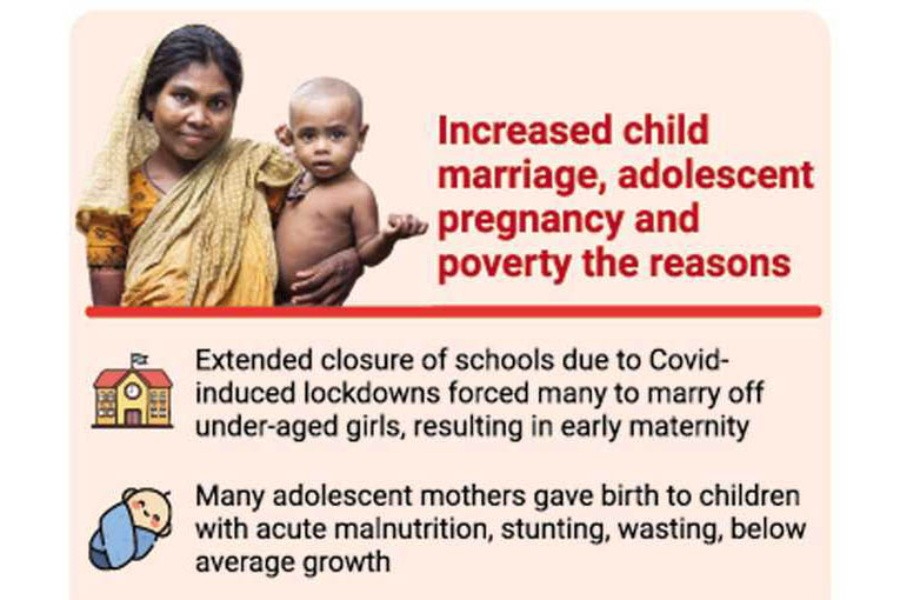The maternal and child nutrition efforts in the country, especially in the coastal belt, have become challenging amid increased child marriage, adolescent pregnancy, climate change, unawareness, and above all poverty.
Extended closure of educational institutions due to recurring lockdowns during the Covid-19 pandemic forced many families to marry off under-aged girls that resulted in early maternity.
Many of these adolescent mothers, already in physical distress, gave birth to children with acute malnutrition, stunting, wasting, below average mental and physical growth, etc.
In a yard meeting for pregnant and lactating mothers at Das Para village of Atalia union in Dumuria Upazila, most of the participants said they are aware of nutrition, hygiene, and health issues but the problem lies in affordability.
Shipra Rani Das, a mother of two, said, "Through the health workers in the village, I know that using sanitary napkin instead of rags can prevent health problems like ovary infection but who will buy me the product? ...husband and mother-in-law don't pay attention to such needs."
A community promoter (health campaigner) of the village, Krishna Mandal, at the meeting, said most of the mothers now know about the benefits of eating healthy and nutritious food during pregnancy, but in reality they can't always access such food.
"Obviously poverty is a reason behind it but there is also issues related to social perspective because those pregnant and lactating mothers face hard time from the elderly family members about food intake," she said.
Referring to ovary infection that sometimes turned into gynaecological cancer, she said many women do not know that simply avoiding bath in salinity enriched pond water during menstrual cycle can save them from that life threatening disease.
Currently, such infection is pretty common among women in the coastal belt which can be prevented through hygienic living and avoiding bath in pond water during the menstrual cycle, said Shapna Dhali, a community healthcare provider (CHCP) at a community clinic in Rangpur union of Dumuria.
According to the Obstetrical and Gynecological Society of Bangladesh (OGSB), the annual mortality rate per 100,000 women from ovarian cancer in Bangladesh has increased by 40.3 per cent since 1990, an average of 1.8 per cent per year.
OGSB said there are five types of gynaecological cancer, of them the most prevalent is cervical cancer while ovarian cancer comes second.
Under-nutrition is estimated to be the main underlying factor in 45 per cent of all deaths among children under five years while Bangladesh is one of the top countries (84th out of 120) that are most affected by hunger and malnutrition, according to the Global Hunger Index 2022.
As per the Sustainable Development Goal (SDG) 3, Bangladesh needs to reduce maternal mortality to less than 70 per 100,000 live births, as well as neonatal (less than one-month old) deaths to 12 per 1,000 live births and child (under-5) deaths to 38 per 1000 by 2030.
According to the Ministry of Health and Family Welfare, under-five mortality rate in Bangladesh is now 29.1 per 1,000 live births, infant mortality 22.6 per 1,000 live births, and maternal mortality rate is 165 per 100,000.
Chasing these targets has been tough due to child marriage and adolescent pregnancy, meanwhile, long school closure due to the Covid-19 pandemic has further worsened the child marriage situation whilst the situation is even worse among the lower-caste Hindus and dalit community.
"As there are limited scopes of education for dalit girls, a number of them get married after completing primary school," said Shuili Mandal, headmaster of Dalit Shisu Kendra Primary School at Ramkrishnapur village of Rangpur union in Dumuria.
Basana Mandal, a mother of two girls, belonging to dalit, married off her first born at the age of 13 due to poverty and social pressure.
She said, "My girl suffered from long-standing health complications after the child birth at home while the child itself was born with a defect on its left leg."
UNICEF data showed that Bangladesh is home to about 38 million child brides, at least 13 million of whom were married before the age of 15.
Of these child brides, nearly five out of 10 gave birth before the age of 18 while eight out of 10 gave birth before the age of 20.
According to the Child Marriage Restraint Act, 1929, amended in 2017, it has been illegal for a girl under 18 and a boy under 21 to be wed off.
Ashish Kumar Kabiraj, civil society organisation (CSO) vice-president in Dumuria Upazila, said, "Sometimes we fall in moral dilemma in case of stopping child marriage as the girl's family falls in grave distress due to poverty and for them it isn't that easy to find a good bridegroom that often."
Besides, many families wed off their adolescent girls going to relative's home in another village which makes it difficult to stop such marriage by CSOs and support networks, he said.
Israt Hasan, project coordinator of Right2Grow (R2G) project in Dumuria, said better coordination among the local government bodies, public representatives, CSOs, NGOs and field workers can bring good result in ensuring nutrition for all, preventing child marriage, access to better sanitation, etc.


